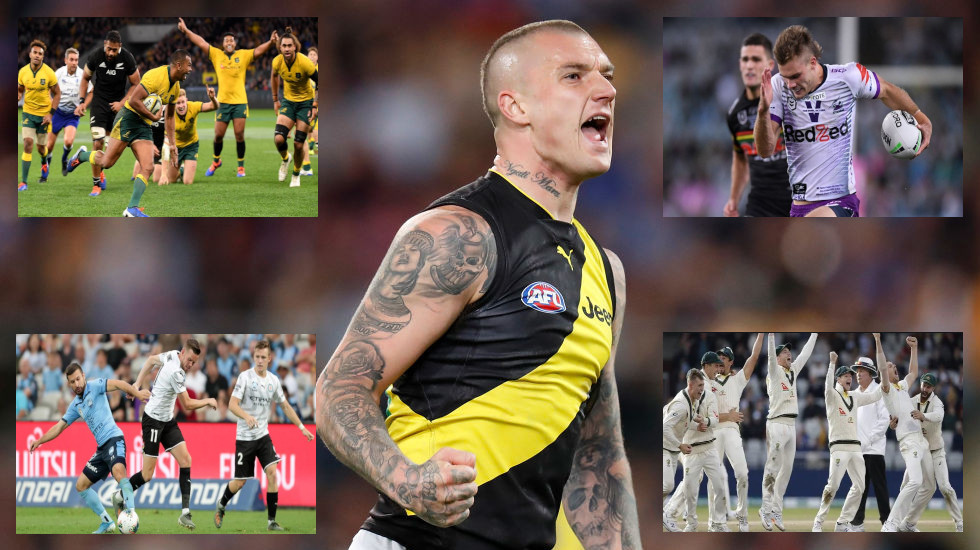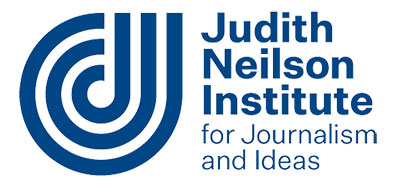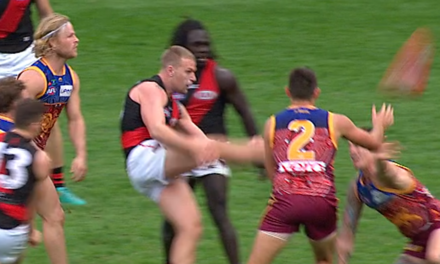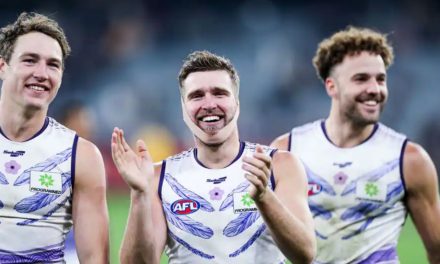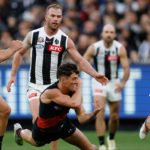Dustin Martin, a star of “Australia’s Game”. But the AFL has competition from rugby union, league, soccer and cricket.
Happy Australia Day. Now that we have settled that we are “one and free”, let’s start another divisive debate on what is Australia’s true “national sport” (to distract us from the question of just when Australia Day should be celebrated).
We have in the back of our minds that well-worn but everlasting jingle from the 1970s about what makes up Australia and its culture, “Football, meat pies, kangaroos and Holden cars …”
But which “football”? Which game with an air-filled ball is our national sport?
The AFL has claimed the title with its promotional catchphrase of being “Australia’s Game”. It certainly is Australia’s most-popular football code in a nation that remarkably works four codes – Australian football, rugby as union and league and soccer (that makes, with justification, its calling card the “World Game”).
There is one meaningful quality both forms of rugby and soccer do have – a blessing that has eluded Australian football since its beginnings in 1858 when we were still trying to build a nation (on differing railway gauges).
Each of the “imported” football codes has uniformity – a rule book that not only applies from Brisbane to Broome, but also from Innsbruck to Istanbul. The off-side rule in soccer does not have differing interpretations across various leagues in the same nation. Australian football cannot say the same with its tormented holding-the-ball rule.
Despite AFL chief executive Gillon McLachlan last year – amid a review of the game’s structure, particularly in the “second tier” that lives under the high-profile18-team national league – vowing to deliver a “global view”, season 2021 will begin with Australian football being like the nation’s railways … on different tracks in different states.
The new VFL (that has absorbed the NEAFL teams from Brisbane, Gold Coast, Sydney and Greater Western Sydney) starts with a rule book that includes experimental rules.
The most significant – to help the AFL football department in its battle against congestion but not the game’s image of confusion – is the demand “three players (must be) stationed inside 50 metres, including one player in the goal square, for all kick-ins and boundary throw-ins”.
The SANFL – that regards itself as the best state league – will have its unique “last touch” rule that the South Australian football leadership argues has enhanced the game, particularly by encouraging play away from the boundary to the centre corridor. The AFL disagrees on the SANFL’s key point that “last touch” has reduced congestion or stoppages.
The AFL notes the SANFL has fewer boundary throw-ins but more stoppages, thereby concentrating the congestion in the centre corridor.
Former SA Football Commission member Dion McCaffrie responds that it is not one rule change that will save the game from its curse of congestion. “By itself, ‘last touch’ is not enough,” says McCaffrie. “At the same time we also reduced interchange rotations and tightened the holding-the-ball rule.”
Ah, the holding-the-ball rule … that critical piece of the rule book that is “interpreted” differently state by state, league by league. Even game by game on some days.
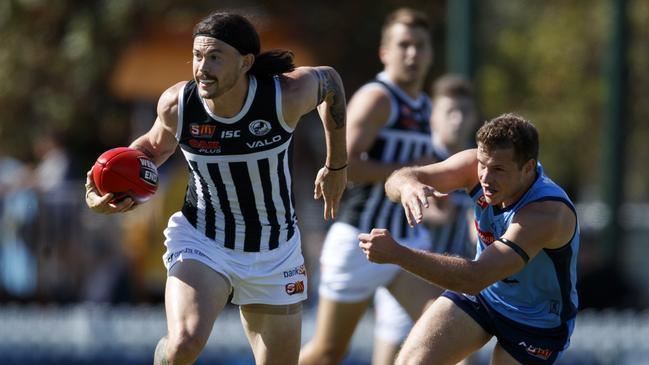
The SANFL’s “last touch” rule is just one example of different rules for different Australian football competitions.
McLachlan’s “global view” still needs a man of vision to match Christopher Columbus. Watching a VFL game in Brisbane will carry nuances that vary from an AFL match in Melbourne that will be umpired differently to an SANFL encounter in suburban Adelaide.
This is “Australia’s Game” … how much of Australia?
Cricket, tennis, golf and the Olympic disciplines of athletics, swimming, volleyball, basketball, hockey et al have a complete national footprint – that is, these sports include major play in Tasmania and the territories, the ACT with Canberra and NT with Darwin and Alice Springs as major centres.
Basketball is embracing the Apple Isle (again) with the Jack Jumpers re-starting NBL play in Tasmania for the 2021/22 national league season, ending a 25-year pause that followed the demise of the Hobart Devils from a 14-team league in 1996.
This will put the NBL in every state and in New Zealand. But basketball, even with a strong international profile with the Boomers and Opals, cannot claim to be Australia’s national sport.
Neither rugby code has a national league presence in Tasmania. Nor does the A-League soccer competition that has joined basketball in expanding offshore to New Zealand.
Rugby is seemingly locked to Australia’s eastern seaboard, but both codes have grasped the opportunity of taking their major events – such as the Bledisloe Cup union battles with New Zealand and league’s big-ticket State-of-Origin grudge sessions between New South Wales and Queensland – to “non-traditional” cities outside their Sydney-Brisbane heartlands.
Australian football is the only domestic football competition with at least two national league teams based in each mainland State. The AFL also, in the pre-COVID world, took great joy in pointing out it played national league games in every Australian state and territory, including Tasmania, where Victorian clubs, Hawthorn (Launceston) and North Melbourne (Hobart), have their second homes.
Australian football has the best national footprint of any football code. But VFL-AFL expansion has repeatedly ignored Tasmania, either on the basis it was commercially wrong to invest in a state with a population of less than 600,000 and an economy with a $32.1 billion GDP (compared with $288.3 billion in Queensland, where the AFL a decade ago preferred to make a $250 million investment in the Gold Coast Suns – a figure recouped in the record $2.5 billion television rights deal in 2015).
And then there also is the challenge of uniting Tasmanian football along its infamous north-south divide at a time when there are disturbing accounts on the condition of the Australian game on the island state.
“The moment has come for the most unifying moment in Tasmanian history,” says Tasmanian-proud broadcaster Tim Lane of the Tasmanian dilemma that would lead to a 19-team national competition (reinstating the complications brought with the bye each weekend).
“The AFL must decide what to do … Tasmanian football will be condemned to a slow death unless it has a team in the AFL. And it has to be its own team.”
This is where the Tasmania debate gets interesting. The non-Victorians jump into the saga that this Tasmanian puzzle offers the “great opportunity” to deal with the high concentration of AFL teams in Melbourne (currently nine; half of the 18 in the so-called national competition – although it might be noted that there also often is a high count of London-based clubs among the 20 teams in the English Premier League).
PLEASE HELP US CONTINUE TO THRIVE BY BECOMING AN OFFICIAL FOOTYOLOGY PATRON. JUST CLICK THIS LINK.
Lane, along with many passionate Taswegians, is opposed to the transplanting of a “struggling” Victorian-based club in Hobart, in a repeat of the financially-driven ploys that relocated South Melbourne in Sydney in 1982 and Fitzroy in Brisbane in 1997.
“It’s not the way to go,” says Lane putting forward the argument from the Tasmanian perspective. “Tassie is like a suburb of Melbourne. Tasmanians are passionate followers of Victorian teams. They will wear their team jumpers in the streets – and in the death notices in the newspapers there will be tributes carrying the badges of AFL clubs.
“These people will not change their allegiances to support North Melbourne, but they will switch to support a team that truly represents Tasmania and wears a jumper that reflects Tasmania,” adds Lane, with his point proven in Perth with West Coast and in South Australia with Adelaide.
This all reinforces former Port Adelaide president Greg Boulton’s point that fans barrack for a club and not the game – even “Australia’s Game”.
This is a warning point that should be taken in by those who repeatedly say the AFL needs to “get rid” of its high concentration of Melbourne-based teams that supposedly leads to a Victorian bias at AFL House.
What becomes of those football fans who lose their clubs? Killing clubs is not the answer. More meritorious would be progressing Hawthorn president Jeff Kennett’s promotion-relegation theme … a concept that might grow the game’s base.
No-one can argue the image of Australian football – as “Australia’s Game” – is complete while Tasmania is frozen out of the sport’s top-level national footprint. More so when the island state was part of Australian football’s first national ambitions with those long-lost “Australian national carnivals”.
Then it was Tasmania’s best against the rest … that inevitably led to Taswegians being picked off by cash-carrying football officials from the mainland states of Victoria, South Australia and Western Australia.
This proud collection of Tasmanian-bred footballers will not be the “Tasmania” that plays in a national competition when (or is that “if”?) the island state has an AFL team.
As much as West Coast and Adelaide were originally prepared (even positioned) as “state” teams in WA and SA, the reality of the AFL national draft has turned the Eagles and Crows into club sides often dominated by players (even with captains) from other states. Indeed, Adelaide’s past three skippers – West Australian Nathan van Berlo, New South Welshman Taylor Walker and Victorian Rory Sloane – prove the point.
So does the folly of Crows vice-captain Nigel Smart in his victory speech after Adelaide claimed one of its back-to-back AFL premierships in 1997 and 1998. Smart was not-so clever in saying: “We showed the Vics!” Standing behind Smart was defender Peter Caven, a Victorian who said: “Where do you think I’m from?”
Tasmanian football greats might want to rethink the push to have their famous “map” jumper – that should remain exclusive to true Tasmanian state representative teams – being added to the AFL wardrobe for a club team.
As new Adelaide chairman and former SANFL president John Olsen often says, be careful what you wish for.
More relevant is the Tasmanian wish to have its start-up AFL franchise designed, managed and nurtured by its own – rather than excess staff reassigned from AFL House in Melbourne, as was noted with expansion on the Gold Coast and in western Sydney during the past decade.
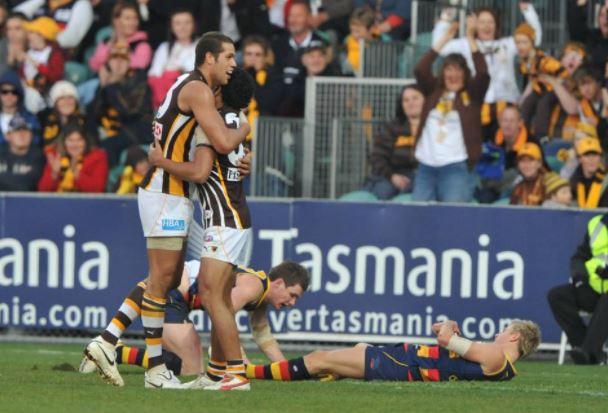
Hawthorn has been playing “home” games in Launceston, Tasmania, for just on 20 years now.
“Australia’s Game”?
This is Australian football, by participation numbers, national footprint, public and media profile and command of the hard-earned corporate dollar.
The game has certainly moved on from 1978 when we were humming “football, meat pies, kangaroos and Holden cars” while mistrust between Victorians and non-Victorians stopped progress for a national league. At the same time, the multicultural tribes of the world game found their unity to establish the Philips National Soccer League (NSL).
Despite the promise of national television audiences from eager networks, the hope Australian football could be “Australia’s Game” with a national club competition in the late 1970s was wrecked by a supposedly “dictatorial attitude of the Victorian Football League”.
Naturally, the South Australians were most outspoken, with then SANFL (the ‘N’ denoting national for a state league) general manager Don Roach leaving a meeting with the VFL on national league ambitions saying: “It’s terribly frustrating – the VFL wants to go national but under its own terms. (It) is geared for Victorian teams.”
And that agenda finally came true with VFL national expansion from 1987 with the advent of West Coast in Perth and those Brisbane Bears.
Of the four football codes, three – soccer and the two rugby games – allow young men and women to rise from club sport to represent their nation in genuine international competition. The Socceroos, the Matildas, the Wallabies, the Wallaroos, the Kangaroos, the Jillaroos …. Australian football is not so fortunate. Even the men have to compromise on rules to wear a national jumper against Ireland. So can Australian football be Australia’s national sport?
A lack of true international competition did not stop the NFL, with American football surpassing another home-grown international and Olympic sport, baseball, in becoming the most-popular game in the USA. Baseball’s image as America’s “national pastime” certainly was hurt in the 1990s when player strikes destroyed the fans’ faith.
Although, US researcher Michael Schottey debunks this theory, saying the NFL gained the crown of America’s national sport from baseball by being “more exciting”.
If television ratings make the case, the NFL certainly has won the battle. Baseball games – that are not played to football’s time limit with strictly timed quarters or halves – often drag on beyond two hours, not helping the sport’s appeal.
And this might serve as the warning that Australian football should not take its standing for granted. The question always remains which other football code or sport would drag Australian football off the pedestal?
Soccer has for so long had the opportunity, but not the vision (even David Hill’s masterplan to “de-ethnicise” Australian soccer’s national league failed). Basketball has not made its claim. Rugby league’s expansion vision requires much more than the bluster of Peter V’landys to supersede the AFL’s hold on the self-claimed title of “Australia’s Game”.
Still, for all the bragging that comes with this debate, there is a memorable thought from Kevin Sheedy while Australian football’s master salesman took up the challenge of creating an AFL footprint in rugby league territory in western Sydney.
How lucky is Australia that in its major city, Sydney, there can be four football codes thriving. Australia, the lucky sporting country.
Happy Australia Day.

